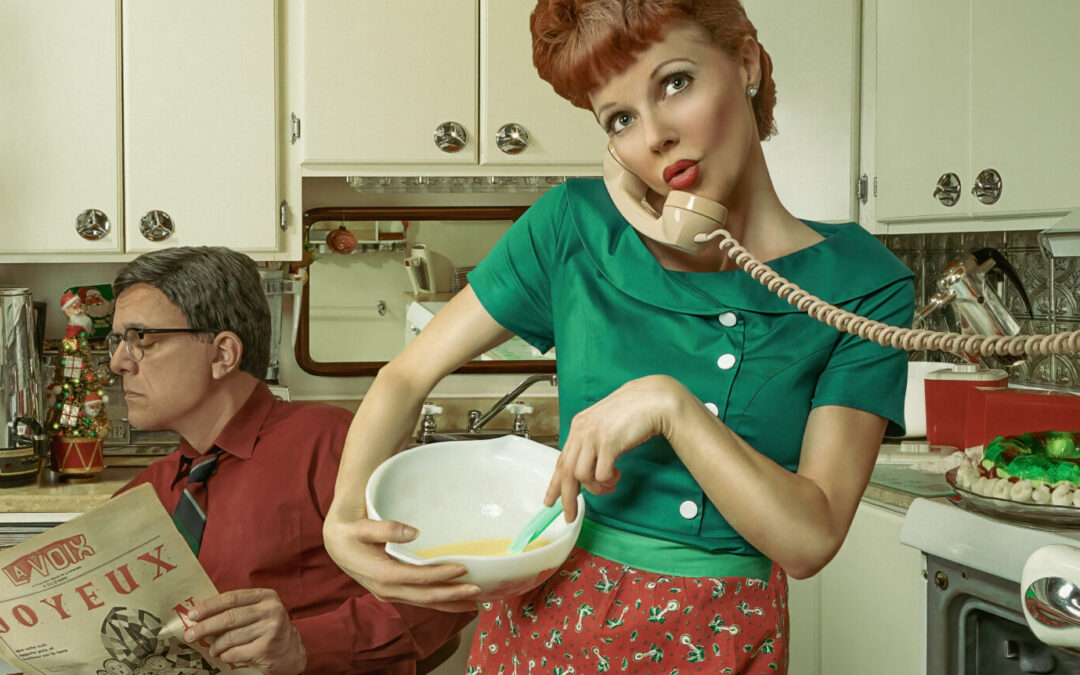Vox recently posed a question that cuts to the heart of the tradwife phenomenon: who is the “trad husband”? Tradwives are everywhere on social media, their content racking up millions of views. But their allegedly dominant spouses remain curiously invisible, standing just outside the camera frame or appearing only as disembodied voices approving the homemade meal.
The invisibility is striking. These women build entire brands around serving their husbands, yet the men themselves are ghosts. We see the apron, the sourdough, the eight children. We rarely see the guy supposedly calling the shots. The trad husband phenomenon is fascinating precisely because the reality contradicts everything the aesthetic promises.
What Are Trad Wives and Trad Husbands?
The “tradwife” movement exploded on TikTok and Instagram over the past few years. Short for “traditional wife,” these women create content showcasing a lifestyle centered on homemaking, cooking from scratch, raising children, and supporting their husbands as the family’s sole breadwinner. Think 1950s aesthetics meets social media: floral dresses, homemade sourdough, and captions that often start with “my husband was craving…”
The biggest names in the space rack up serious numbers. Hannah Neeleman (Ballerina Farm) has over 10 million followers documenting life on her Utah ranch with eight children. Nara Smith, a 22-year-old model, captivates millions with her serene videos making everything from cereal to sunscreen from scratch. The content is mesmerizing, watching these women glide through picture-perfect homes, making multi-course meals while wrangling multiple kids.
Enter the trad husband. He’s the other half of this equation, the man who theoretically makes it all possible by earning enough income to support the entire household. He’s the provider, the breadwinner, the head of household, the reason she can spend her days perfecting homemade pasta instead of commuting to an office. At least, that’s the narrative. The reality is considerably more interesting.
The Visibility Problem

As Vox observed, trad husbands exist on a spectrum of visibility. Some remain remarkably absent from content that’s supposedly about serving them. You’ll catch glimpses of Daniel Neeleman working on the Ballerina Farm ranch, but he’s rarely front and center in Hannah’s videos despite constant references to what he wants or needs.
Then there’s Lucky Blue Smith, Nara’s husband. He appears regularly in her content, and they’ve even done brand campaigns together, including for Skims. But his visibility actually creates a different problem for the tradwife narrative. Lucky is a successful model with his own career. When he’s on-camera, it becomes obvious that both partners are working professionals who create content together. The traditional provider dynamic falls apart because we can see they’re both in the entertainment industry.
The question isn’t really about visibility. It’s about what that visibility reveals. When trad husbands stay off-camera, we can believe the fantasy that he’s at a regular job providing for the family. When they appear too much, like Lucky, we realize this is a dual-career household where both partners are content creators and models. Either way, the traditional setup doesn’t hold up to scrutiny.
The Single-Income Challenge
Being a trad husband in 2025 requires earning enough to support an entire household on a single income. When only 26% of households had dual incomes in 1955, being the sole provider was the norm. Today, 54% of households have two incomes. The math has fundamentally changed.
Housing costs have climbed dramatically. Healthcare, childcare, and education expenses have increased faster than wages. That picture-perfect farm life visible on Instagram requires substantial resources. The trad husband is funding an entire lifestyle that needs to look effortless on camera.
Daniel Neeleman (husband of “tradwife queen” Hannah Neeleman) is the son of JetBlue’s billionaire founder. Many couples leading this movement have family wealth or dual high incomes that make the lifestyle sustainable. The aesthetic may be traditional, but the financial foundation often isn’t.
The Income Paradox Nobody Discusses
Here’s where things get really interesting. Many prominent tradwife influencers are actually out-earning their provider husbands. Hannah Neeleman has over 10 million followers across platforms. Nara Smith pulls similar numbers. Online estimates suggest Smith earns upward of $200,000-$300,000 per month from her content alone.
This creates a fundamental contradiction. She’s not financially dependent. He’s not the sole provider. They’re performing traditional roles while living an utterly modern economic reality. The Instagram captions say “my husband provides,” but the actual bank deposits tell a different story.
Nara and Lucky are both working models and content creators. Hannah runs a meat business alongside her social media empire. These aren’t housewives in any traditional sense. They’re entrepreneurs who film themselves doing domestic labor. The husband’s role, whether he’s visible or not, is to participate in or enable that content creation.
A Modern Take on an Old Role

Modern trad husbands aren’t carbon copies of 1950s fathers who left for the office and returned to dinner on the table. Many are involved fathers who participate in childcare and household decisions. They’re just doing it within a framework where one partner handles most domestic operations.
The role has evolved beyond its mid-century inspiration. Some work from home, others maintain flexible schedules. They’re involved parents who also identify as primary providers. It’s a hybrid that pulls from both traditional and contemporary parenting models.
The Performance Never Ends
The strangest part of the trad husband phenomenon might be this: most of these men aren’t actually living traditional lives at all. They’re married to content creators, business owners, and influencers who happen to film themselves making sourdough. Their wives aren’t financially dependent housewives. They’re entrepreneurs running media companies from their kitchens.
The husbands are playing a role in an elaborate production. Whether they’re showing up on-camera like Lucky Blue Smith doing Skims campaigns with Nara, or staying mostly behind the scenes like other trad husbands, they’re all participating in a performance that requires maintaining the illusion that one partner isn’t working when both clearly are.
The trad husband isn’t really a return to 1950s gender roles. He’s something entirely new: a man whose role is to enable and often participate in his wife’s career as a traditional wife influencer. The contradiction isn’t a bug in the system. It’s the entire business model. And as Vox pointed out, the narrative requires carefully managing how visible these men are, because too much visibility exposes what they actually do all day, and too little visibility makes people wonder who’s really in charge.

